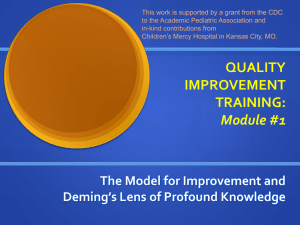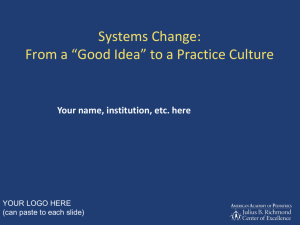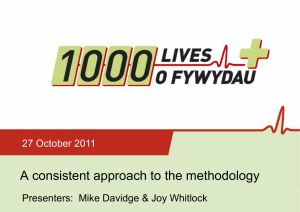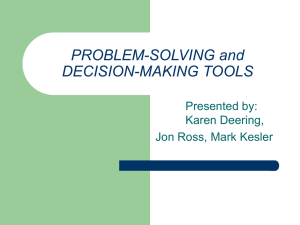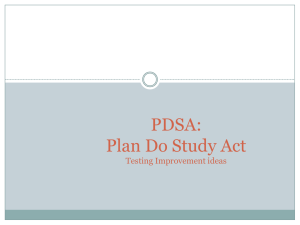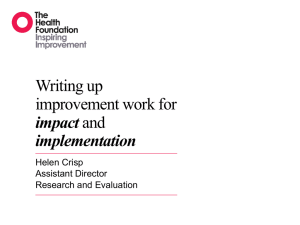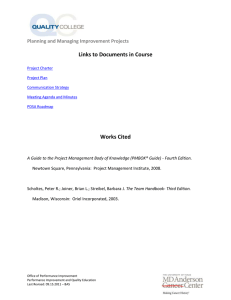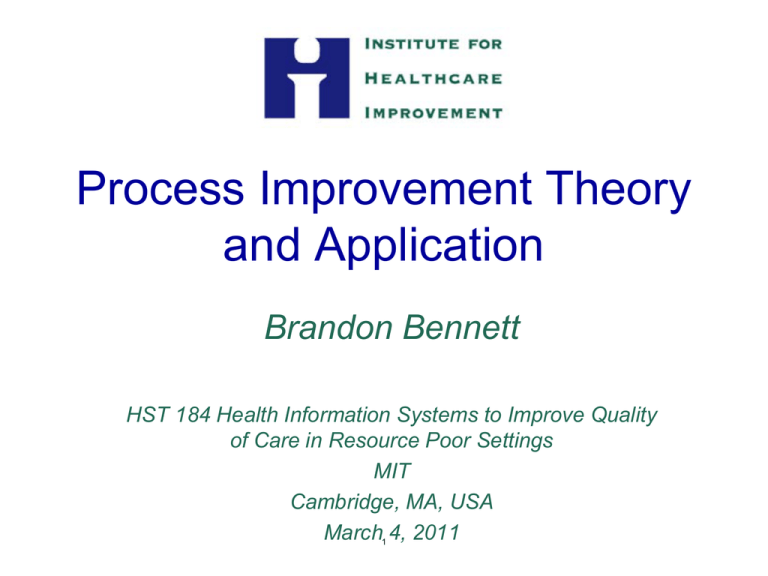
Process Improvement Theory
and Application
Brandon Bennett
HST 184 Health Information Systems to Improve Quality
of Care in Resource Poor Settings
MIT
Cambridge, MA, USA
March 4, 2011
1
Agenda
•
•
•
•
Brief History of Quality Improvement
System of Profound Knowledge
Systems thinking
Model for Improvement
2
Quality Improvement – A brief
History
Three key influences:
• W.E. Deming’s - System of Profound Knowledge
• Walter Shewhart’s – understanding variation through
Statistical Process Control
• Joseph Juran – Juran’s Quality Trilogy
3
Deming’s System of Profound Knowledge
Appreciation
of a system
Image removed of W. Edwards
Deming book, The New
Economics.
Theory of
Knowledge
Psychology
Understanding
Variation
“The aim of this chapter is to provide an outside view – a lens
– that I call a system of profound Knowledge. It provides a map of theory by which to
understand the organizations that we work in.
”
4
Two Types of Knowledge
Subject Matter Knowledge: Knowledge basic to the things we do in life.
Professional knowledge.
Subject Matter
Knowledge
Profound Knowledge
Profound Knowledge: The interaction of the theories of systems, variation,
knowledge, and psychology.
5
Knowledge for Improvement
Improvement: Learn to
combine subject matter
knowledge and profound
knowledge in creative ways
to develop effective changes
for improvement.
Subject Matter
Knowledge
Profound Knowledge
Langley: 76
6
Activity 1
NO
Step 1:
Pick a number
from 3 to 9
Step 3:
Add 12 to the
number from step 2
Step 2:
Multiply your
number by 9
Do
you have
a 2-digit
Number?
YES
Step 4:
Add your 2
digits together
Step 8:
Go to the next
Letter: A to B,
B to C, C to D,
etc.
Step 5:
Divide # from step 4
by 3 to get a 1
digit number
Step 9:
Write down the name
of an animal (not bird,
fish, or insect) that
begins with your letter
from Step 8
Step 6:
Convert your
Number to a letter:
1=A 2=B 3=C
4=D 5=E 6=F
7=G 8=H 9 = I
Step 10:
Write down
the color of
your
animal
7
Step 7:
Write down the
name of a country
that begins with
your letter
Output:
Color____________
Animal___________
Country__________
Understanding Systems
• What is a system?
─System = a collection of processes working
together to produce a defined output
• “Every system is perfectly designed to
achieve the results it gets”
» Paul Batalden – Dartmouth
8
Linkage of Process
9
Organization as a System
Plan to
Improve
Driver
Process
Suppliers
Design & Redesign
of Processes,
Products & Services
Market
Research
Need
Purpose of the
Organization
Measurement
& Feedback
A
B
Mainstay
Process C
Production of Product or Service Distribution
D
E
F
G
Support
Process
Support Process
Courtesy of Cliff Norman.Used with permission.
©API, Inc. 2002 All Rights Reserved
10
Outcome for
Clients
Process Mapping
• What is a process map?
• Simply put, it is a way of visualizing all the
steps which make up a process
11
Process Map
• Related Terms/Tools
─Flow Chart/Diagram
─Causal Loop Diagram
─Value Stream Analysis
─Swim Lane diagram (Matrix/Group Flow
Diagram)
─Others?
12
Nomenclature
Fig 10-2, Improvement Handbook
A Rectangle indicates that an activity is being performed. A
description is usually displayed inside the rectangle
A Diamond represents a decision point in the process. Usually a
question is displayed inside the decision symbol. Possible
answers to that question then form exit routes from the diamond
A Document symbol represents a document that is either an input
or an output of a process. A description of the document is
displayed inside the symbol
A Terminal symbol identifies the “Start” or “End” of a process
A Connector Symbol is used to show a branch or extension of a
flow diagram
Arrows represent the direction of flow for a
13
process
Simple Example
ART to
mother
Counsel and
testing of
mother
CD4
count
DT to
mother
14
DT to baby
PCR Testing for
the Infant
Data Flow Diagram
Register 1
Register 2
Unit 1
Register 3
Register 1
Monthly Report
Unit 2
Register 2
Possible
Error Points
in Data
Transfer
15
District Office
Setting Aims
16
Appreciation
of a System
Where in the System
of Profound
Theory of
Knowledge are we Knowledge
learning?
Psychology
Understanding
Variation
17
Setting Aims
Should be impossible within the current
framework of how our system functions
Should embody these key elements
• Ambitious
• Measurable
• Time Limited
• Very Specific
18
Setting an Aim
• First answering the Question
─“What are you trying to accomplish?”
• Appreciation of the destination
─Take advantage of these questions
─“How much?”
─“By when?”
Langley et. al.
19
With Your Project Teams
• Each Team could develop and write an
aim statement related to your project
20
Reviewing our Aim Statements
• Are the key questions addressed (how much
and by when?)
• Is the aim specific?
• Is it ambitious?
• Is it clear to anyone who will read it?
• Where could it be improved/made more
simple?
21
The Model for Improvement
Shewhart
Deming
Langley et. al.
22
Appreciation
of a System
Where in the System
of Profound
Knowledge are we
learning?
Theory of
Knowledge
Psychology
Understanding
Variation
23
Model for Improvement
What are we trying to
accomplish?
What change can we make
that will result in improvement?
How will we know that a change
is an improvement?
Act
Plan
Study
Do
24
Langley, et al.
Question 1:
What are we trying to accomplish?
• In the context of project planning this
might be your overall aim, however,
when used to introduce a change
through the PDSA cycle, a PDSA
specific aim should be identified
• As with setting our initial aim, we should
answer this question as specifically as
we can
25
Question 2:
What change can we make that will result in an
improvement?
Sources of Change Ideas
• people providing the service
• Clients
• best practice
• Guidelines
• change ideas/concepts
• novel ideas developed through creativity
methods
• identifying underlying challenges (root
cause analysis)
26
Question 3:
How will we know a change is an improvement?
Measurement is critical to tracking change
• “no data, no improvement”
• measurement may differ from
process/outcome measures, meaning an
individual PDSA may capture data about
performance at one step in a process that
you normally do not collect
27
ACT:
•
PLAN:
•
What changes are
to be made?
What will be the
next cycle?
•
•
•
STUDY:
•
•
•
Langley et. al
•
Complete the
analysis of the
•
data.
Compare data to
predictions.
Summarize what
•
was learned.
28
State objective of the
cycle.
Make predictions.
Develop plan to carry out
cycle…(who, what, where,
when).
DO:
Carry out the
test.
Document
problems and
unexpected
observations.
Begin analysis of
the data.
PDSA Cycles
• Gives you a way to try out your ideas to improve
the system before deciding to implement
• Allows you to know quickly whether your change
will work
• Gather data to convince your colleagues that the
change will work
• Focus on small steps (will not disrupt your work)
29
Key Points in PDSA cycles
• Every plan has a prediction – what you
think will happen
• Be as specific and as small as possible
• Should be measurable with data collection
being very important
• Should be analyzed for success and acted
upon through a new plan or a scaled up
cycle
30
With your team
• Develop your first PDSA
• Create a plan for your initial PDSA Cycle,
something you can test next week
─What do you believe about why things are the
way they are?
─What do you want to learn?
─What can you test quickly?
31
Problem:
Aim of this change:
The Change:
ACT:
PLAN:
(Who, what,
where,when,
how)
Abandon
Adapt
Adopt
STUDY:
DO:
Prediction:
32
Measurement
Rapid Cycle Change
What are we trying to
accomplish?
PLAN
DO
ACT
What can we change that
will result in an
improvement?
STUDY
PLAN
DO
ACT
DO
ACT
PLAN
STUDY
PLAN
STUDY
DO
ACT
How will we know that a
change is an improvement?
STUDY
33
Eshowe, KZN, South Africa
34
With your Team
• With your team think about how you would
use the PDSA cycle method to build
confidence
• Think 2 or 3 cycles ahead – what
problems might you anticipate?
• Will this change work only for a few
patients or for all patients?
• Who needs to be engaged from leadership
for this to succeed?
35
Knowing when to implement a
change
36
Degree Belief and Next PDSA
Cycle
Improvement Guide, 2009, p. 144
37
Appropriate Scope for a PDSA
Cycle
Staff Readiness to Make Change
Current Situation
Low
Confidence
that change
idea will lead to
Improvement
High
Confidence
that change
idea will lead to
Improvement
Resistant
Indifferent
Ready
Cost of
failure
large
Very Small Scale
Test
Very Small Scale
Test
Very Small Scale
Test
Cost of
failure
small
Very Small Scale
Test
Very Small Scale
Test
Small Scale Test
Cost of
failure
large
Very Small Scale
Test
Small Scale Test
Cost of
failure
small
Small Scale Test
Large Scale Test
Large Scale Test
Implement
38
Improvement Guide, 2009
Final Thoughts and Questions
Questions for Discussion:
• What are the most significant barriers to
improvement in health-care organizations?
• What is the PDSA cycle?
• What are the key ingredients for success
in making rapid cycle change?
39
Some References
Langley G., Nolan K., Nolan T., Norman C., Provost L. (1996, 2009) The Improvement Guide: A
practical approach to enhancing organizational performance. Jossey-Bass
Institute for Healthcare Improvement – www.ihi.org – Recommended IHI white papers
Deming W.E. Out of the Crisis (1982)…..
Lloyd, R (2004) Quality Health Care; A guide to developing and using indicators. Jones and Bartlett
Publishers
Donabedian, A (1980) Explorations in Quality Assessment and Monitoring. Volume 1: The definition of
Quality and Approaches to Its Assessment. Ann Arbour, Mich.: Health Administration Press
Mate KS, Bennett B, Mphatswe W, Barker P, Rollins N (2009) Challenges for Routine Health System
Data Management in a Large Public Programme to Prevent Mother-to-Child HIV Transmission in
South Africa. PLoS ONE 4(5): e5483. doi:10.1371/journal.pone.005483
Ackoff, Russell, L. 1981. Creating the Corporate Future, John Wiley & Sons.
Senge, Peter M. 1990. The Fifth Discipline. New York: Doubleday/Currency.
40
MIT OpenCourseWare
http://ocw.mit.edu
HST.S14 Health Information Systems to Improve Quality of Care in Resource-Poor Settings
Spring 2012
For information about citing these materials or our Terms of Use, visit: http://ocw.mit.edu/terms.
41

